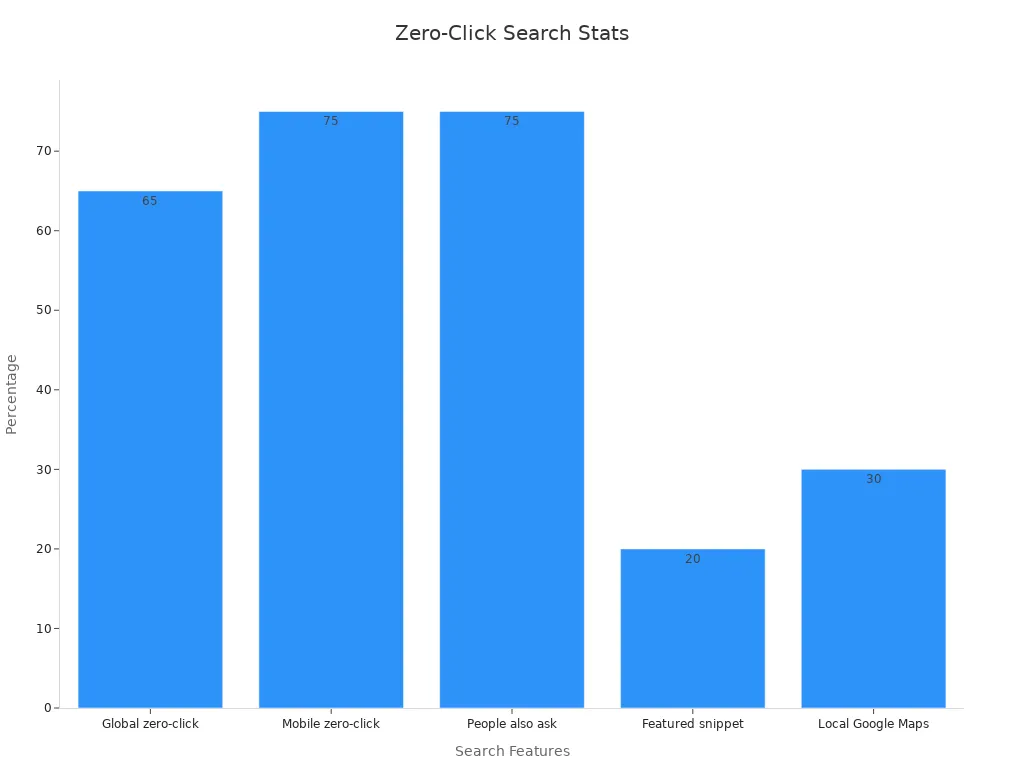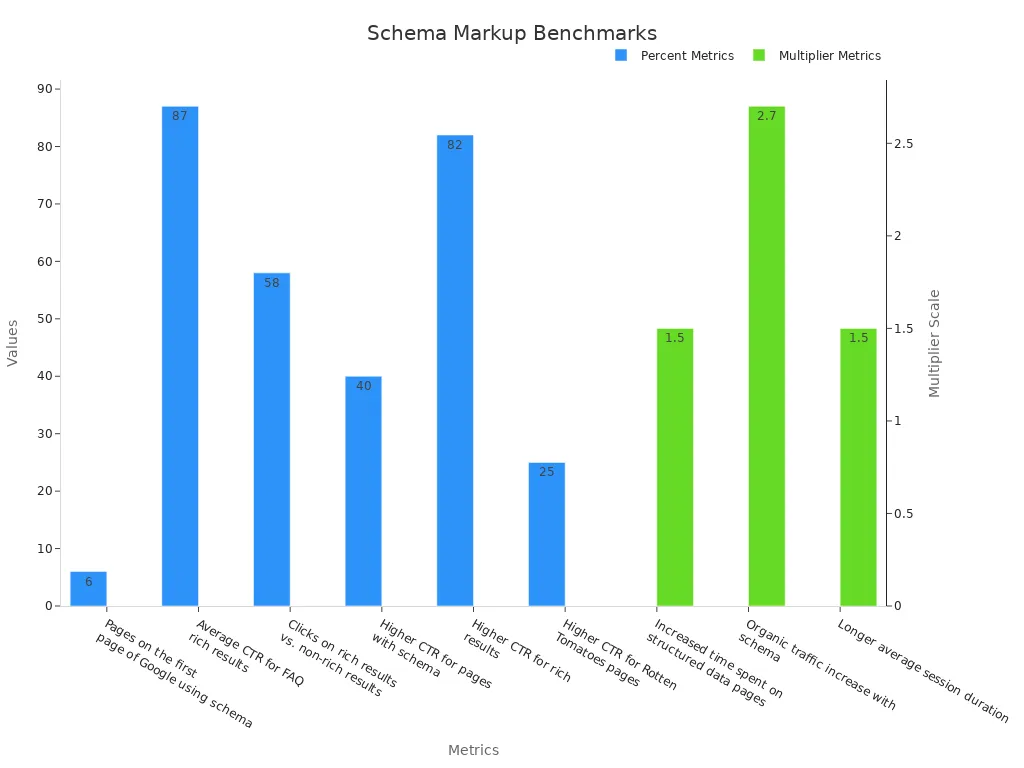
Zero-click searches have transformed how users interact with search engines. By 2025, they dominate search engine results, offering instant answers through features like Featured Snippets and Knowledge Panels. Nearly 60% of searches now result in no external clicks. Adapting to this trend ensures your business remains visible and competitive in today’s evolving digital landscape.
Key Takeaways
-
Zero-click searches give quick answers on search pages. This means people don’t need to click links. Businesses should focus on being seen and connecting with users, not just getting website visits.
-
Making content for featured snippets and knowledge panels builds trust in your brand. Write clear and short answers to common questions. This helps your content show up in these special search features.
-
Using schema markup makes your content easier to find online. It helps search engines understand your content better. This can lead to more clicks and user interaction.
Understanding Zero-Click Searches

What Are Zero-Click Searches?
A zero-click search happens when a user finds the information they need directly on the search engine results page (SERP) without clicking on any external links. These searches rely on features like featured snippets, knowledge panels, and local packs to deliver instant answers. For example, if you search for “current weather,” the result often includes a weather widget showing the temperature and forecast right on the SERP.
This shift in search behavior reflects how users increasingly value quick, accessible information. According to Bain’s research, 80% of consumers depend on zero-click results at least 40% of the time. This trend highlights the growing importance of adapting your marketing strategies to align with AI-driven search results. Instead of focusing solely on driving traffic to your website, you should prioritize metrics like conversions, buyer intent, and brand visibility.
Examples of Zero-Click Search Features
Zero-click searches encompass a variety of SERP features designed to provide immediate answers. Here are some common examples:
-
Featured Snippets: These are concise answers displayed at the top of the SERP, often in response to a question.
-
Knowledge Panels: These panels provide detailed information about a topic, such as a company, person, or event.
-
Local Packs: These highlight nearby businesses, often including maps, reviews, and contact details.
-
Direct Answers: These include quick facts like dates, times, or statistics.
-
Weather Widgets: These show real-time weather updates.
-
Calculators: These allow users to perform basic calculations directly on the SERP.
To illustrate the prevalence of these features, consider the following statistics:
|
Statistic |
الوصف |
|---|---|
|
65% |
Estimated percentage of all global searches on Google that are zero-click in 2024. |
|
75% |
Percentage of mobile searches resulting in zero clicks. |
|
20% |
Proportion of search results occupied by featured snippets. |
|
30% |
Percentage of local searches featuring Google Maps listings. |

These features demonstrate how search engines aim to meet user needs directly on the SERP. By understanding and leveraging these tools, you can ensure your business remains visible in a zero-click search environment.
Why Zero-Click Searches Are Crucial
Impact on Website Traffic and User Behavior
Zero-click searches are reshaping how users interact with search engines. When answers appear directly on search results pages, fewer users click through to websites. This shift impacts traditional metrics like website visits and click-through rates. You may notice a decline in organic search traffic, especially if your content isn't optimized for zero-click features like featured snippets or knowledge panels.
On mobile devices, the effect is even more pronounced. Over 75% of mobile searches result in zero clicks, leaving businesses to rethink how they measure success. Instead of focusing solely on traffic, you should evaluate how your content surfaces in search results and engages users directly on the SERP. This approach ensures your brand remains visible even when users don't visit your site.
The prevalence of zero-click searches highlights the need for new strategies. By delivering answers directly on the SERP, search engines prioritize user experience. You can adapt by creating content that aligns with this behavior, ensuring your business stays relevant in the age of zero-click searches.
Importance for SEO and Business Growth
Zero-click searches are not just a challenge; they are an opportunity to enhance brand recognition and authority. When your content appears in featured snippets or knowledge panels, it positions your brand as a trusted source of information. This visibility builds credibility and fosters user trust, even if users don't click through to your website.
SEO in the age of zero-click searches requires a shift in focus. Instead of optimizing solely for clicks, you should prioritize appearing in high-value SERP features. These features, such as local packs and “People Also Ask” boxes, allow you to reach users at critical moments in their search journey. By leveraging these tools, you can drive engagement and conversions without relying on traditional traffic metrics.
The rise of zero-click searches also emphasizes the importance of adapting your digital marketing strategies. With 65% of global searches resulting in zero clicks, businesses must embrace new metrics to measure success. Tracking impressions, engagement, and brand visibility on the SERP can help you understand how your content performs in this evolving landscape.
Actionable Strategies to Optimize for Zero-Click Searches

Focus on Featured Snippets and Knowledge Panels
To thrive in a zero-click world, you need to target featured snippets and knowledge panels. These SERP features provide users with immediate answers, positioning your brand as a trusted authority. To appear in these features, focus on creating concise, well-structured content that directly answers common user queries.
Here are some metrics to measure success when optimizing for these features:
-
Impressions and SERP Visibility: Use tools like Google Search Console to track how often your content appears in search results.
-
Brand Lift and Awareness Metrics: Evaluate how well users recognize your brand after seeing it in search results. Tools like Google Trends can help.
-
Engagement Beyond Google: Monitor direct traffic and branded search growth to understand how users interact with your brand outside of Google.
By focusing on these metrics, you can refine your content strategy and ensure your business remains visible in a zero-click search environment.
Leverage Schema Markup for Better Visibility
Schema markup is a powerful tool for optimization. It helps search engines understand your content better, increasing the chances of appearing in rich results like FAQs, reviews, and event listings. Adding schema markup to your pages can significantly boost visibility and engagement.
|
Metric |
1TP15التالي |
|---|---|
|
Pages on the first page of Google using schema |
|
|
Average CTR for FAQ rich results |
87% |
|
Clicks on rich results vs. non-rich results |
58% |
|
Higher CTR for pages with schema |
40% |
|
Organic traffic increase with schema |
2.7x |

Implementing schema markup is one of the most effective technical SEO techniques to improve your SERP presence. Use structured data types like FAQ, HowTo, and LocalBusiness to enhance your content's visibility.
Create High-Value, Zero-Click Content
High-value, zero-click content is essential for building brand authority. This type of content provides immediate answers, making it ideal for featured snippets and knowledge panels. Users trust brands that consistently appear in these formats, which can lead to future engagement.
To optimize zero-click content:
-
Answer questions early in your content, ideally within the first 2–3 sentences.
-
Use clear formatting, such as bullet points and tables, to make information easy to digest.
-
Focus on creating content that aligns with user intent and provides value directly on the SERP.
By prioritizing zero-click content, you can enhance your brand's visibility and credibility without relying on traditional click-through metrics.
Optimize for Local Search and Google Business Profile
Local search plays a critical role in zero-click searches. Nearly 46% of all Google searches focus on local information. To optimize for local search, set up and maintain a Google Business Profile. This ensures your business appears prominently in local packs and Google Maps.
Key strategies include:
-
Keeping your Google Business Profile updated with accurate information.
-
Encouraging customers to leave reviews to build trust.
-
Using Google Posts and Q&A sections to engage users directly on the SERP.
By implementing these strategies, you can improve your local search visibility and strengthen your brand identity.
Target People Also Ask (PAA) Boxes
People also ask boxes are another valuable zero-click feature. These boxes provide users with related questions and answers, offering multiple opportunities for your content to appear on the SERP. To optimise for people also ask, create content that addresses common user queries in a conversational tone.
Good content structuring is crucial for targeting PAA boxes. Use headings, subheadings, and bullet points to organize your content effectively. This approach not only improves readability but also increases the chances of your content being featured in PAA boxes.
Use Conversational Content to Address User Intent
Conversational content is key to addressing user intent in a zero-click context. Users increasingly rely on AI-generated summaries and featured snippets for quick answers. By adopting a conversational tone, you can align your content with this trend.
Tips for creating conversational content:
-
Write in a natural, engaging style that mimics how users speak.
-
Focus on answering specific questions directly and concisely.
-
Use tools like Google Trends to identify trending queries and tailor your content accordingly.
By incorporating conversational content into your strategy, you can better meet user needs and enhance your visibility in zero-click searches.
Measuring Success in a Zero-Click Search Environment
Track SERP Features and Rankings
To measure success in a zero-click search environment, you need to track how often your content appears in high-visibility SERP features. These include featured snippets, local packs, and People Also Ask (PAA) boxes. Monitoring these appearances helps you understand your brand's visibility and its ability to capture user attention directly on the search engine results page.
Investing in the right tools is essential for accurate tracking. Tools like STAT, Semrush, and AccuRanker allow you to monitor your position and visibility across AI-influenced search results. Google Search Console’s performance reports also provide valuable insights into your content’s reach. Additionally, brand monitoring tools can help you capture offline impact, while keyword tracking tools reveal how your rankings perform for specific search terms.
Tip: Run regular AI overview audits to see how often your site is cited in generative search results. This can help you identify opportunities to improve your presence in zero-click searches.
Monitor Organic Impressions and Click-Through Rates
In a zero-click environment, impressions become a critical metric. They show how often users see your content, even if they don’t click through to your website. By focusing on impressions, you can gauge your content’s reach and its ability to engage users directly on the SERP.
Click-through rates (CTR) remain important, but their role has evolved. Instead of solely measuring traffic, CTR now reflects how compelling your content is within the context of zero-click searches. For example, a high CTR for a featured snippet indicates that users find your content valuable enough to explore further.
To monitor these metrics effectively, use tools like Google Search Console and SEO platforms with SERP feature tracking. These tools provide detailed reports on impressions, CTR, and other performance indicators.
|
الوصف |
|
|---|---|
|
Impressions and Engagement |
Measure how many people are seeing your content, even if they’re not clicking through. |
|
SERP Feature Appearances |
Track how often your content appears in Featured Snippets, Local Packs, or PAA boxes. |
|
Brand Mentions and Sentiment |
Assess if people are discussing your brand and the sentiment surrounding those mentions. |
|
Business Impact |
Monitor brand recognition and its correlation with broader goals like MQL/SQL and sales. |
Evaluate Brand Visibility and Engagement Metrics
Brand visibility is a cornerstone of success in a zero-click search landscape. Even without direct clicks, appearing in AI overviews and featured snippets can significantly enhance your brand’s awareness. Users trust brands that consistently provide valuable answers directly on the SERP.
To measure visibility, focus on metrics like search impressions and search position. Higher rankings increase your chances of being featured in AI summaries and other high-visibility SERP features. Tracking your presence in these features helps you understand how well your content aligns with user intent.
Engagement metrics also play a vital role. Monitor brand mentions and sentiment to assess how users perceive your brand. Tools that track mentions in generative search results can provide deeper insights into your brand’s impact. Additionally, evaluate how your visibility correlates with broader business goals, such as lead generation and sales.
Note: Shifting your focus from driving traffic to enhancing visibility and engagement ensures your brand remains competitive in a zero-click environment.
Optimizing for zero-click searches ensures your business stays competitive in a rapidly evolving digital landscape. AI overviews and emerging technologies are reshaping search optimization, making traditional strategies less effective. By prioritizing SERP visibility and creating platform-native content, you can foster engagement and build trust. This approach secures long-term success in search performance.
التعليمات
What is the best way to appear in Featured Snippets?
Focus on answering questions clearly within the first few sentences. Use bullet points or tables to structure your content for easy readability.
How can you track zero-click search performance?
Use tools like Google Search Console to monitor impressions, SERP feature appearances, and engagement metrics. These insights help you refine your optimization strategy.
Does optimizing for zero-click searches reduce website traffic?
It may reduce clicks but boosts visibility. Users trust brands that provide answers directly on the SERP, increasing engagement and long-term credibility.








